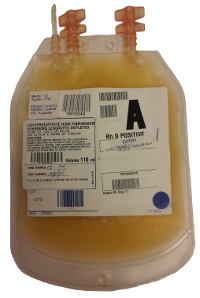Presentation
- 80-120mL (contains approx. 1.1 - 1.3g fibrinogen)

ABO & RhD Compatibility
ABO
- Providing the product does not contain an ABO haemolysin (strong anti A or B antibody), Cryoprecipitate may be given without regard to ABO type. Where an ABO haemolysin (lysin) is present it may only be given to a recipient with a compatible ABO group (see plasma compatible donor group table above). This will be indicated on the label of the cryoprecipitate as "For ABO Identical Recipient Only".
Rh(D)
- No anti-D immunoglobulin need be given if Rh(D) negative patients receive Rh(D) positive FFP or cryoprecipitate.
- Although frozen plasma components may contain small amounts of red cell stroma, sensitisation following transfusion of Rh(D) positive units is most unlikely, as stroma is less immunogenic than intact red cells. Therefore Cryoprecipitate of any Rh(D) type may be given regardless of the Rh(D) type of the recipient. Contact Blood Bank if you are not sure.
Storage
- Once issued, Cryoprecipitate should be transfused as soon as possible.
- Once thawed, Cryoprecipitate may be stored at room temperature for up to 4 hours.
- Never store Cryoprecipitate in a fridge.
- If the transfusion cannot be started within 30 minutes, return Cryoprecipitate to Blood Bank immediately for appropriate storage.
Filter
- Use a standard blood infusion set which has a 170-200 micron filter
- The infusion set should be changed when the transfusion is complete, or after 12 hours.
- All fresh components, including cryoprecipitate, are leucodepleted at source by NZBS. No bedside leucodepletion is necessary.
Pump
- Approved infusion pump devices may be used.
Rate and Duration
- Paediatrics:
- in a non-bleeding patient: infuse at 10-20mL/kg/hr
- in resuscitation: cryoprecipitate can be infused more rapidly based on the patient's haemodynamics
- Adults:
- in a non-bleeding patient: most adults will tolerate a unit of cryoprecipitate every 30 minutes.
- Consider a slower rate in patients with or at risk of congestive cardiac failure.
- Infusion of all components should be completed within 4 hours of leaving refrigerated storage.
Monitoring
- See page on Observations
DO NOT
- DO NOT add medication to Cryoprecipitate
- DO NOT use 5% Dextrose solutions (may induce haemolysis)
- DO NOT use Lactated Ringer's or other balanced salt solutions that contain Calcium, as this may induce clot formation in the blood bag and / or administration set.
Dose
- The standard therapeutic dose for cryoprecipitate is 1 unit per 30kg bodyweight. This provides enough fibrinogen to raise the fibrinogen level by 1g/L.
- For paediatric patients, a standard therapeutic dose is approximately 3mL/kg.
- For paediatric patients, the dose should be written in mL, not units.
Dose Calculator
More Info